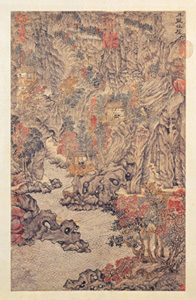Home >> Art >> Painting >> Masters >> Wang Meng Forest Chamber Grotto Mount Taibai Painting Gallery
Wang Meng (王蒙, 1308-1385) was a Chinese painter during the Yuan dynasty. His style name was Shuming (叔明); sobriquets Huanghe Shanqiao (黃鶴山樵), Xiangguang Jushi (香光居士). A native of Wuxing (吳興, modern Huzhou 湖州, Zhejiang 浙江), he was a grandson of the famous artist Zhao Mengfu (趙孟頫, 1254-1322).
Wang Meng served in a minor capacity in the governments of both the Yuan and the Ming but was linked (erroneously, it was later revealed) with the prime minister Hu Weiyong (胡惟庸) who conspired against the Ming emperor Taizu; as a result, he was imprisoned for the last five years of his life.
Wang Meng’s painting followed the styles of Wang Wei (王維, 701-761), Dong Yuan (董源, 10th c.), and Juran (巨然, 10th c.), establishing a style of his own and becoming one of the Four Great Masters of the Yuan along with Huang Gongwang (黃公望, 1269-1354), Wu Zhen (吳鎮, 1280-1354), and Ni Zan (倪瓚, 1301-1374).
Wang Meng was a close friend of Ni Zan, whose paintings are typically thin and spare, whereas Wang's are thick and dense with agitated forms and much ink. His brushstrokes piled one on another to produce masses of texture combined in dense and involved patterns. Like those of Ni, however, his paintings show less interest than those of his Yuan predecessors in deliberately opposing the pictorially splashy Southern Song (1127–1279) academic traditions through the conscious exploitation of archaic pictorial means; instead, they place more emphasis upon uniqueness and privacy of vision, an individual attitude encouraged by the revolution brought about in the earlier landscape painting of the Yuan dynasty.
Artworks by Wang Meng (view the entire painting gallery)
